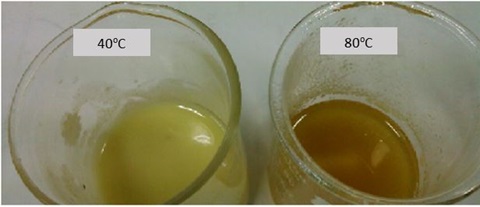Exploration of Novel Lipase from Plant Seeds and Plant Latexes
Abstract
As the demand for fatty acids increases, the enzymatic process of triglyceride hydrolysis emerges as a promising technology. Compared to microbial lipase, utilization of plant lipase is more practical due to its ease of preparation and cost-efficiency. This work aimed to verify the degree of lipolysis of several novel lipase sources from plants. Novel lipase sources investigated were seeds of kapok (Ceiba pentandra), java almond (Sterculia foetida), pongam (Milletia pinnata), sea mango (Cerbera manghas), tamanu (Calophyllum inophyllum), latex of sea mango, aveloz (Euphorbia tirucalli), and jackfruit (Artocarpus heterophyllus). Several acknowledged plant lipase sources were also compared, i.e. seeds of castor bean (Ricinus communis), physic nut (Jatropha curcas), rice bran (Oryza sativa), latex of frangipani (Plumeria rubra) and papaya (Carica papaya). Plant lipase was utilized in the hydrolysis of olive oil at room temperature. Results for seed and latex lipase were compared and technical issues were reported. Several plant lipases are remarkably active and potential to compete with microorganism lipases in industrial applications.
Downloads

Copyright (c) 2024 Astri Nur Istyami, Myra Wardati Sari, Cristy Hagi Gultom, Tirto Prakoso, Tatang Hernas Soerawidjaja

This work is licensed under a Creative Commons Attribution-NonCommercial-NoDerivatives 4.0 International License.
Authors who publish with this journal agree to the following terms:
- Copyright on any article is retained by the author(s).
- The author grants the journal, the right of first publication with the work simultaneously licensed under a Creative Commons Attribution License that allows others to share the work with an acknowledgment of the work’s authorship and initial publication in this journal.
- Authors are able to enter into separate, additional contractual arrangements for the non-exclusive distribution of the journal’s published version of the work (e.g., post it to an institutional repository or publish it in a book), with an acknowledgment of its initial publication in this journal.
- Authors are permitted and encouraged to post their work online (e.g., in institutional repositories or on their website) prior to and during the submission process, as it can lead to productive exchanges, as well as earlier and greater citation of published work.
- The article and any associated published material is distributed under the Creative Commons Attribution-NonCommercial-NoDerivatives 4.0 International License.





_copy1.png)










